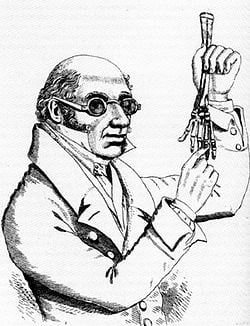Killers Burke and Hare

Burke and Hare
In the 1820's there were insufficient corpses available for the Universities to teach the study of anatomy. Their only supply of cadavers came from the authorities who turned over the bodies of criminals who had been executed for their crimes. These bodies were essential for the students to dissect and to therefore gain greater knowledge of the human body, and the parts that made them up. Medical Science in the Universities started to flourish, and the demand for dead bodies increased dramatically. At this time there was also a sudden decrease in the number of corpses available, as criminals were starting to be deported to the colonies for their crimes. The shortage attracted those who realised they could profit from this and who were unscrupulous enough to obtain bodies by any means. A pair of Irish immigrants, William Burke and William Hare had emigrated to Scotland to work as labourers on the Union Canal. They soon spotted a way to earn some easy money : they could kill people and sell the bodies to the University of Edinburgh.
Hare had married Margaret Laird the widow of a boarding house keeper in West Port Edinburgh. Margaret kept the business going while Hare kept his job on the canal.
Burke married Helen McDougal and the four became friends. When one of the boarding house tenants died of natural causes, Burke and Hare contacted a lecturer in medical Science, Doctor Robert Knox and he agreed to take the body, telling them he would take as many corpses as they could supply. The serial killers were on their way to riches. They weighed down the coffin and buried it, then took the corpse to Doctor Knox. The next victim was a boarder who became ill. They plied him with whisky, then smothered him. The two wives joined in enthusiastically, and started selecting victims for their husbands to kill. This was easy money! From November 1827 to October 1828 they murdered sixteen people who were then cut up by Dr. Knox and his students.
The serial killers continued the gruesome business of contributing to medical science, until by chance, they were caught. Their last victim was Marjory Campbell Docherty whom Burke had invited into the boarding house, telling her that his mother was a Docherty. There were a husband and wife in the house so Burke couldn't dispose of Docherty straight away. He had to wait until James and Ann Gray collected their belongings and left. When Ann Gray returned the next morning to collect something she'd left behind, Burke would not let her into the bedroom where she thought she'd left her belongings. Ann returned later with her husband and they went into the bedroom. There, under the bed they found the body of Marjory Campbell Docherty.
The killers removed the body from the house before the police arrived, but when questioned, Burke claimed that Docherty had left at 7:00 a.m., while his wife said that she had left in the evening. They were both arrested. Then a tip-off led the police to Knox's lecture room where they found Docherty's body, which James Gray identified. William and Margaret Hare were arrested soon after.
The Lord Advocate offered Hare and his wife immunity if they confessed and agreed to testify against Burke, and like the despicable pair that they were, they did so. Their testimony led to Burke's conviction in December 1828. Burke was executed by hanging on 28 January 1829, after which he was treated the same way that his victims were, by being publicly dissected at the Edinburgh Medical College. To add to the irony, and to get the message across to other would - be killers, the dissecting professor used Burke's blood to write, quote, "This is written with the blood of Wm Burke, who was hanged at Edinburgh. This blood was taken from his head."
McDougal was set free as her complicity to the murders could not be proved. Knox got away scot free, despite the public's outrage. Burke swore in his confession that Knox had known nothing of the origin of the cadavers.
The Hare's were released in February 1829, and there are stories told about William Hare being a blind beggar in London, having been mobbed and thrown into a lime pit. However, none of these reports have been confirmed. The last known sighting of him was in the English town of Carlisle.
Up the close and down the stair,
But and ben with Burke and Hare.
Burke’s the butcher, Hare’s the thief,
Knox, the boy who buys the beef.
—19th-century Edinburgh jumping-rope rhyme








